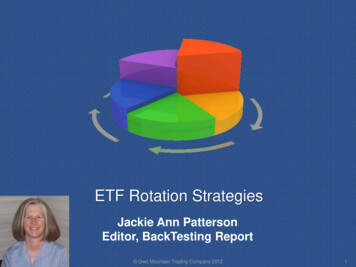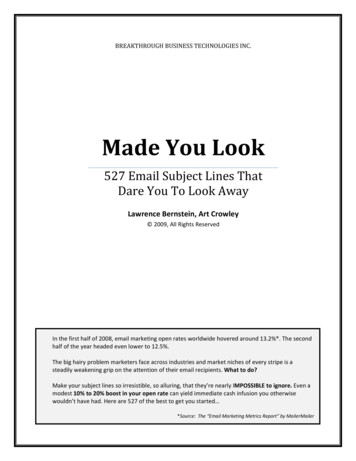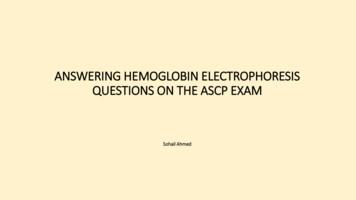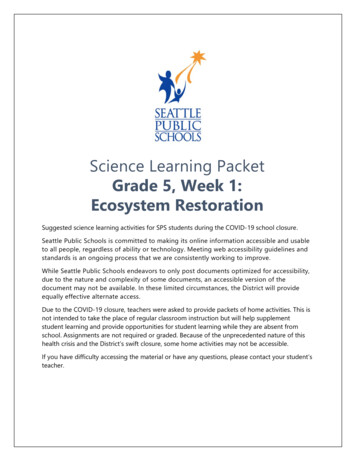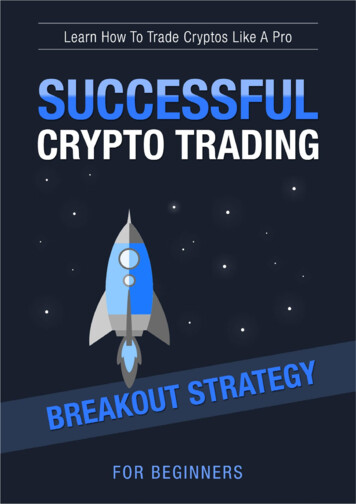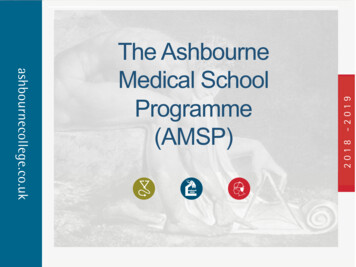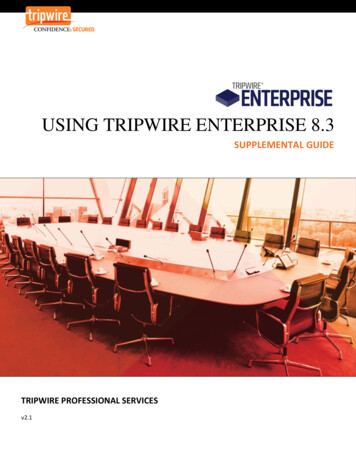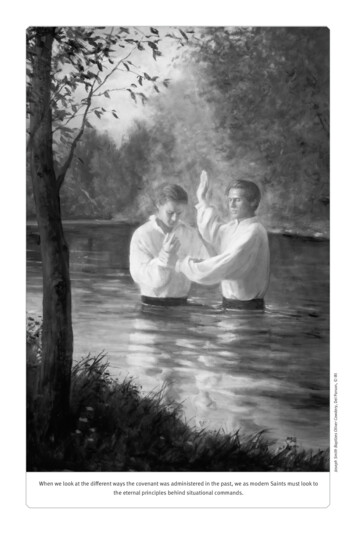
Transcription
Joseph Smith Baptizes Oliver Cowdery, Del Parson, IRIWhen we look at the different ways the covenant was administered in the past, we as modern Saints must look tothe eternal principles behind situational commands.
New and Everlasting:The Relationship betweenGospel Covenants inHistoryke rry mu hlestei n , j osh ua m . sea rs, a n d avr am r . sha n no nKerry Muhlestein (kerry muhlestein@byu.edu) is a professor of ancient scriptureat BYU. Joshua M. Sears (josh sears@byu.edu) and Avram R. Shannon(avram shannon@byu.edu) are assistant professors of ancient scripture at BYU.Members of The Church of Jesus Christ of Latter-day Saints speak ofcovenants in general, baptismal covenants, temple covenants, the newand everlasting covenant, the Abrahamic covenant, and the Mosaic or Sinaicovenant. But what are these covenants, and how are they related to eachother? Students in many settings experience confusion about these questions.1 Each book of scripture shares aspects of covenants that students maynot understand as well as they could. Greater clarity will allow them to drawmore power from scriptural and current prophetic teachings about the centrality of the covenant in every dispensation.Brief Descriptions of Various CovenantsThe scriptures speak of several different covenants.2 Provided below is a briefoverview of how the scriptures and modern prophets describe some of thesecovenants.3RE · VOL. 21 NO. 2 · 2020 · 21–40 21
22Religious Educator · VOL. 21 NO. 2 · 2020The (New and) Everlasting CovenantIn the Doctrine and Covenants, the Lord speaks of “mine everlasting covenant” (Doctrine and Covenants 1:15, 22; 45:9; 49:9; and 66:2), “theeverlasting covenant” (76:101; and 88:131, 133), and “the new and everlasting covenant” (132:6, 19, 26, 41–42). The revelations define this “everlastingcovenant” as “the fulness of my gospel” (66:2; see also 133:57). “The gospelitself,” President Joseph Fielding Smith elaborated, “is the new and everlastingcovenant and embraces all of the agreements, promises, and rewards whichthe Lord offers to his people.”4The “everlasting” part of that name is apt, for this covenant existedeven before the world was created. The plan laid out in the Grand Councilincluded the idea that God’s children would be cut off from his presence. Italso included the promise that God would provide a way for us to overcomethat separation. We further learned that the means by which God wouldkeep his promise would be his Son, Jesus Christ. Joseph Smith taught thatthe Father and Son agreed to this covenant together: “Everlasting covenantwas made between three personages before the organizations of the earth . . .called God the first, the Creator, God the second, the Redeemer, and Godthe third, the witness or Testator.”5 President John Taylor taught, “A covenantwas entered into between Him [Christ] and His Father, in which He agreedto atone for the sins of the world, and He thus, as stated, became the Lambslain from before the foundation of the world [see Moses 7:47].”6Although this covenant is “everlasting,” it is also “new” whenever it isrevealed afresh to people on earth. President Taylor explained that this eternal covenant is “new” only in the sense that it is “new to the world at present,because of their traditions, their follies and weaknesses, and their creeds,opinions and notions,” which led to the necessity of a restoration.7Baptism, Eternal Marriage, and Priesthood as New and EverlastingCovenantsAlthough the scriptures refer to “the” new and everlasting covenant todescribe the totality of gospel ordinances, promises, and responsibilities,they describe certain ordinances, promises, or responsibilities as “a” new andeverlasting covenant. Doctrine and Covenants 22:1 describes baptism as “anew and an everlasting covenant, even that which was from the beginning.”Similarly, Doctrine and Covenants 132:4 describes eternal marriage as “a newand an everlasting covenant.” Numbers 25:13 refers to the priesthood as a
New and Everlasting: The Relationship between Gospel Covenants in History23“covenant” that is “everlasting.” Elder Marcus B. Nash explains this linguisticdistinction: “Neither baptism nor eternal marriage is ‘the’ new and everlasting covenant; rather, they are each parts of the whole.”8The Lord’s Covenants with Adam and Eve, Seth, Enoch, and NoahThe Book of Moses indicates that after Adam and Eve were cast out of thepresence of God, they felt an immediate desire to regain that presence insome way, for they “called upon the name of the Lord” (Moses 5:4). God’sanswer to that need was to covenant with Adam and Eve.9 While the specific details of establishing that covenant are not recorded, the Book of Mosespreserves just enough of an account to let the reader know it happened. Welearn that as Adam and Eve were performing sacrifice after being cast out ofthe garden, an angel taught them that their sacrifices were “a similitude of thesacrifice of the Only Begotten of the Father” (5:7). The Lord also told them,“I am the Only Begotten of the Father from the beginning, henceforth, andforever, that as thou hast fallen thou mayest be redeemed, and all mankind,even as many as will” (5:9). This appears to be part of the covenant-makingprocess for Adam and Eve.The Book of Moses continues: “And thus the Gospel began to bepreached, from the beginning, being declared by holy angels sent forth fromthe presence of God, and by his own voice, and by the gift of the Holy Ghost.And thus all things were confirmed unto Adam by an holy ordinance” (Moses5:58–59). What was the “holy ordinance” spoken of ? While it definitelyincludes the sacrifices Adam and Eve had been making, it seems to encompasssomething more. Later in the Book of Moses, Enoch recalled that God taughtAdam and Eve about repentance, baptism, and the gift of the Holy Ghost (see6:51–52). When Adam asked why men needed to be baptized, God taughtthem that because of their Fall, sin and death had entered the world and thatthe only way to overcome them was to be born again. He spoke of baptism aspart of that process of rebirth, justification, and sanctification (see 6:53–60).Adam was then carried by the Spirit into the water and was baptized, afterwhich he received the Holy Ghost (see 6:64–66). God declared, “Thou artafter the order of him who was without beginning of days or end of years,from all eternity to all eternity. Behold, thou art one in me, a son of God; andthus may all become my sons” (6:67–68). In this way, Adam partook of theordinance of baptism and began the process of reunification with God that
24Religious Educator · VOL. 21 NO. 2 · 2020the covenant was designed to bring about. As discussed below, baptism wasAdam’s entrance into the new and everlasting covenant.The scriptures contain relatively little information about God’s covenantswith Adam and Eve’s descendants before the time of Abraham, althoughmodern revelation provides much more than does the Old Testament alone.Some of Adam and Eve’s children rejected the opportunity to covenant withGod, while others embraced it (see Moses 5:12–15). Although Cain slewhis brother Abel, “God revealed himself unto Seth, and he rebelled not, butoffered an acceptable sacrifice. . . . And to him also was born a son, and hecalled his name Enos. And then began these men to call upon the name ofthe Lord, and the Lord blessed them” (6:3–4). The Joseph Smith Translationof Genesis 9:15 explicitly identifies the Lord’s blessing to Enoch as being “mycovenant.” Later, God told Noah, “Behold, I establish my covenant with you,and with your seed after you” (Genesis 9:9).Little is known of the history of the covenant between the days of Noahand the time of Abraham. The Book of Mormon contains the only information on this, for the Jaredites presumably had some version of the covenant.Still, for anything in this time span, we mainly extrapolate based on how thegospel was administered in other eras. It is only with Abraham that the OldTestament becomes more specific regarding God’s covenants.10The Abrahamic Covenant“The Abrahamic covenant” is a collective term for responsibilities and blessings the Lord gave to Abraham and Sarah and their posterity.11 This particularfamily was given a singular mission: “In thee shall all families of the earthbe blessed” (Genesis 12:3; repeated in 18:18; 22:18; 26:4; and 28:14). Thisimportant mission statement is one of the few quoted across all the standardworks (see also Acts 3:25; Galatians 3:8; 1 Nephi 15:18; 22:9; 3 Nephi 20:25,27; Doctrine and Covenants 110:12; 124:58; and Abraham 2:11). Latter-dayrevelation clarifies that the “blessings” that Abraham and Sarah’s family areto bring to all the rest of the families of the earth are none other than “theblessings of the Gospel, which are the blessings of salvation, even of life eternal” (Abraham 2:11). Beginning with Abraham and Sarah, the crucial workof saving both the living and the dead has been linked with this family line.Abraham and Sarah’s family covenanted to walk blamelessly before theLord, to follow his ways and do what is right and just, and to obey his voiceand keep his commandments (see Genesis 17:1; 18:19; and 26:5). To help
New and Everlasting: The Relationship between Gospel Covenants in History25them fulfill their mission, the Lord promised that if they fulfilled their obligations under the covenant that he would bless them with an innumerableposterity (see 13:16; 15:5; 17:2, 4–6; 22:17; and 28:14), land for an inheritance (see 13:14–15, 17; 17:8; 26:3–4; and 28:13), prosperity and protectionfrom their enemies (see 12:3; 17:6; 18:18; and 22:17), and the privilege ofhaving the Lord, Jehovah, to be their God (see 15:1; and 17:7–8). Latter-dayrevelation adds that this family would be blessed with the priesthood as theyministered to all nations (see Abraham 2:9, 11).The covenant made with Abraham and Sarah continued through theirson Isaac, about whom the Lord said, “I will establish my covenant with himfor an everlasting covenant, and with his seed after him” (Genesis 17:19). TheLord also covenanted with Isaac and Rebekah’s son Jacob, saying, “I am theLord God of Abraham [and] Isaac. . . . In thee and in thy seed shall all thefamilies of the earth be blessed” (28:13–14).12 Later, Jacob was renamed Israel(see 32:28), and he, his wives, and their twelve sons and their wives becamethe ancestors of the Israelite tribes.13The Sinai CovenantCenturies later, once the children of Israel were delivered from slavery inEgypt, they traveled to Mount Sinai for the express purpose of entering intoa covenant with God. Biblical scholars often refer to Exodus 20:22–23:33 asthe Covenant Code because the details of what Israel is expected to do aspart of the covenant are outlined there, but additional descriptions are foundthroughout Exodus 19–40, as well as the books of Leviticus, Numbers, andDeuteronomy.14 The people initially agreed to keep this covenant sight unseenbecause of all the Lord had done for them in bringing them out of Egypt (seeExodus 19:8). After receiving a detailed outline of covenantal obligations, theIsraelites again agreed to the covenant as it had been explained to them (see24:3). They officially entered the covenant via sacrifice and a formal reading ofthe terms of the covenant to the congregation (see 24:4–8). After these events,the Israelites were defined by the covenant they made with God at Sinai.15The Relationship between These Various Gospel CovenantsWe have now defined the everlasting covenant; described the way that baptism,eternal marriage, and other ordinances relate to the everlasting covenant; andreviewed various historical covenants such as the covenants made with Adamand Eve, Abraham and Sarah, and the children of Israel through Moses. But
26Religious Educator · VOL. 21 NO. 2 · 2020how are all these covenants related? Are these the same covenant by differentnames, or are they distinct from each other?It regularly happens that a covenant remains in force even though themanner of administration or the specific requirements undergo changes. Asone example, in both the New Testament and the Book of Mormon, Christdirected his people to drink wine as a part of the sacrament. This practicecontinued in the early history of The Church of Jesus Christ of Latter-daySaints, but eventually the wine was substituted with water. Elder OrsonF. Whitney recalled that a priest from another church once came to Utahand criticized this change; it “made him shudder.” Elder Whitney, however,explained that “divine revelation adapts itself to the circumstances and conditions of men, and change upon change ensues as God’s progressive work goeson to its destiny.”16 The covenant associated with partaking of the sacramentremains the same, even if the specifics of the ordinance change.In the same way, although the everlasting covenant has been administered in different ways and the specific commands associated with it havevaried throughout history, the covenant itself remains the same in its essentials. The Prophet Joseph Smith stressed this essential unity of the gospel planacross dispensations:We cannot believe that the ancients in all ages were so ignorant of the system ofheaven as many suppose, since all that were ever saved, were saved through thepower of this great plan of redemption, as much before the coming of Christ assince; if not, God has had different plans in operation (if we may so express it), tobring men back to dwell with Himself. And this we cannot believe, since there hasbeen no change in the constitution of man since he fell. . . .We may conclude, that though there were different dispensations, yet allthings which God commanded to His people were calculated to draw their mindsto the great object, and to teach them to rely upon God alone as the author of theirsalvation, as contained in His law.17Similarly, President Joseph F. Smith taught that the everlasting covenantis universal:We have entered into the bond of that new and everlasting covenant agreeing thatwe would obey the commandments of God in all things whatsoever he shall command us. This is an everlasting covenant even unto the end of our days. . . . We shallnever see the day in time nor in eternity, when it will not be obligatory. . . . It isupon this principle that we keep in touch with God, and remain in harmony withhis purposes. It is only in this way that we can consummate our mission, and obtainour crown and the gift of eternal lives, which is the greatest gift of God. Can youimagine any other way?18
New and Everlasting: The Relationship between Gospel Covenants in History27President Harold B. Lee taught that there has been continuity in theway that God has administered the gospel of Jesus Christ in every age: “Itwas perpetuated in a regular succession from Adam to Noah and from Noahto Melchizedek, Abraham, Isaac, Jacob, Joseph, Moses, Samuel the prophet,John, Jesus, and His apostles.”19Recognizing the essential continuity of the covenant across dispensations,as well as the historical differences in the way the covenant was administered,is essential. Below, both the similarities and differences between the variousforms of the covenant will be explored in greater detail.Continuity and Change from Adam and Eve to Abraham and SarahAlthough the Bible says little about the relationship between the covenantsGod made with Adam, Noah, or Abraham, it is clear in Restoration scripture that Abraham wanted to make the same covenant that Adam himselfhad made and that he and Sarah were able to do so.20 (See Kerry Muhlestein,“Recognizing the Everlasting Covenant in the Scriptures,” in this issue.)Abraham tells us he “sought for the blessings of the fathers” (Abraham 1:2).He clarifies that this means he sought “to be a greater follower of righteousness, and to possess a greater knowledge, and to be a father of many nations,a prince of peace, and desiring to receive instructions, and to keep the commandments of God” (1:2), all of which are covenantal elements. Abrahamalso wanted to have the right “to administer” those blessings (1:2), whichindicates that the blessings were something that could only be administeredby authority. Only a covenant fits that description. Abraham then tells usthat “it [the blessings] was conferred upon me from the fathers; it came downfrom the fathers, from the beginning of time, yea, even from the beginning, orbefore the foundation of the earth, down to the present time, even the rightof the firstborn, or the first man, who is Adam, or first Father, through thefathers unto me” (1:3).Modern prophets have also taught that the Abrahamic covenant is thesame covenant that Adam and Eve had made—what we call the new andeverlasting covenant.21 President Wilford Woodruff said, “Men, in the days ofAbraham, Isaac and Jacob, and of Jesus and the Apostles, had blessings sealedupon them, kingdoms, thrones, principalities and powers, with all the blessings of the New and Everlasting Covenant.”22 President Gordon B. Hinckleytaught, “The Lord . . . said that one reason for the restoration was that Hiseverlasting covenant might be reestablished [see Doctrine and Covenants
Religious Educator · VOL. 21 NO. 2 · 2020281:22]. That covenant . . . was made between Abraham and Jehovah when themighty Jehovah made a great and solemn promise to Abraham.”23Although Abraham and Sarah received all the blessings of the new andeverlasting covenant, there were some differences between the Abrahamiciteration of the covenant and the version given to Adam and Eve. For example, after Abraham’s day, anyone who was not part of Abraham and Sarah’sfamily but who wanted to be part of the covenant would have to be adoptedas part of their “seed” (see Abraham 2:10). Because their family line was nowintegral to the salvation of the whole world, their descendants must always bespared from complete destruction and must always be gathered back to Godso that they can perform God’s work (see, for example, Leviticus 26:40–45).24Further, a specific land was promised to Abraham and Sarah’s descendants(see Genesis 15:18–21). Despite the innovation that began with Abrahamand Sarah’s having a land and using their family to take the Lord’s blessingsto the rest of the world, it was in its essence still the same eternal covenantestablished with Adam and Eve.Continuity and Change from Abraham and Sarah to Moses and IsraelAs the story of the Israelites’ exodus from Egypt opens, it pays careful attention to the covenant the Lord had established with their ancestors: “Andtheir cry came up unto God by reason of the bondage. And God heard theirgroaning, and God remembered his covenant with Abraham, with Isaac, andwith Jacob” (Exodus 2:23–24). To Moses, God declared, “I am the Lord:and I appeared unto Abraham, unto Isaac, and unto Jacob. . . . And I havealso established my covenant with them. . . . And I have heard the groaningof the children of Israel, whom the Egyptians keep in bondage; and I haveremembered my covenant” (6:2–5). From the beginning of the Exodus story,it is clear that the new covenant God will make with the Israelites grows outof the covenant already in force.25The Sinai covenant lists several of the specific responsibilities and blessings of the Abrahamic covenant: God promises prosperity (see Genesis 15:1; 17:16; and Abraham 2:9;compare Leviticus 25:18–19; 26:4–5, 10; Deuteronomy 6:3; 28:3–6,8, 11–12; 29:9; and 30:0, 16).
New and Everlasting: The Relationship between Gospel Covenants in History 29God blesses them with a promised land (see Genesis 12:1, 7; 13:14,17; 15:17–18; 17:8; and Abraham 2:6, 9; compare Exodus 6:8;Leviticus 18:24–30; 25:18; Deuteronomy 5:33; 6:1; and 30:16, 20).God grants protection (see Genesis 15:1, 17; 22:17; and 24:60;compare Leviticus 25:18; 26:5–8; Deuteronomy 6:19; 26:8; and28:10–12).They will rule rather than be ruled (see Genesis 17:6, 16; compareLeviticus 26:13; and Deuteronomy 28:36, 43–44).They will have a special relationship with God (see Genesis 17:7–8;Abraham 1:19; and 2:7; compare Exodus 6:7; 19:5–6; Leviticus26:12; Deuteronomy 7:6; and 29:9–13).They must keep God’s commandments (see Genesis 17:9; Abraham1:2; and 2:6; compare Exodus 19:5; Leviticus 18:5, 24–30; 25:18;26:3; Deuteronomy 5:1, 33; 6:1–2, 17; 7:11; 26:3; 28:1, 9, 14–15;and 30:8, 10, 16, 20).Some aspects of the Abrahamic covenant are not clearly identifiablein the Sinai covenant as recorded in our Old Testament; however, they aredescribed elsewhere by people who lived the Sinai covenant: They are to bring the gospel to all nations of the earth (see Genesis12:3; 18:18; 22:18; Abraham 1:18–19; and 2:6–11; comparethis with the Nephites’ understanding of the covenant in 1 Nephi15:17–18; 22:9; and 3 Nephi 20:25, 27).26God will bless those that bless Abraham and curse those that curseAbraham (see Genesis 12:3; and Abraham 2:11; compare this with theteachings of Israel’s prophets regarding how nations react to Israel inIsaiah 41:10–16; 59:18; 60:14; Jeremiah 30:16; and Zechariah 8:13).In addition to these parallel descriptions of the Abrahamic and Sinaicovenants, there are also several Old Testament passages that explicitly drawa connection between the two. For example, Deuteronomy enjoins theIsraelites to keep the covenant, “that thou mayest love the Lord thy God, andthat thou mayest obey his voice, and that thou mayest cleave unto him: for heis thy life, and the length of thy days: that thou mayest dwell in the land whichthe Lord sware unto thy fathers, to Abraham, to Isaac, and to Jacob, to givethem” (Deuteronomy 30:20). Moses had explained to Israel that the Lordwas making the covenant with them because he loved them and also because
30Religious Educator · VOL. 21 NO. 2 · 2020he wanted to honor the promise he had made to their fathers, a clear reference to the covenant with Abraham, Isaac, and Jacob (see Deuteronomy 7:8).One of the clearest Israelite connections between the Sinai and Abrahamiccovenants is Psalm 105 (paralleled in 1 Chronicles 16).27 In Psalm 105:7–10,the Psalmist praises Jehovah, reminding Israel of their history:He is the Lord our God:his judgments are in all the earth.He hath remembered his covenant for ever,the word which he commanded to a thousand generations.Which covenant he made with Abraham,and his oath unto Isaac;and confirmed the same unto Jacob for a law,and to Israel for an everlasting covenant.Through poetic parallelism, the Psalmist explicitly connects the covenantmade with Abraham to the everlasting law and covenant made with Israel.28In addition to these Old Testament examples, this equation between theAbrahamic and Sinai covenants was made by New Testament–era Jews (see,for example, Acts 3:25; Galatians 3:15),29 Nephite prophets (see, for example,1 Nephi 15:18; 22:9), and the Savior himself when he visited the Nephites(see 3 Nephi 20:25–27). Mormon made an explicit connection when he said,“Then will the Lord remember the covenant which he made to Abraham andunto all the house of Israel” (Mormon 5:20; emphasis added).30 Latter-dayrevelations also make connections between the covenants made with Israeland with Abraham. For example, the Lord told the early Saints that they were“the children of Israel, and of the seed of Abraham” (Doctrine and Covenants103:17). He also spoke of those who receive the priesthood ordinances of thetemple as becoming both “sons of Moses and Aaron and the seed of Abraham”(Doctrine and Covenants 84:34). After quoting this passage, PresidentJoseph Fielding Smith taught that “the covenant made with Abraham . . . wasrenewed with Jacob and the tribes of Israel.”31Some have suggested that the covenant made between Israel and God atSinai is related to but different from the Abrahamic covenant.32 It would bemore accurate to say that it is the same covenant, though it was once again tailored to the specific time and people who were participating in it.33 When theLord gives Israel the covenant, he tells them it is to make them into “a kingdomof priests, an holy nation” (Exodus 19:6). The goal of this covenant, as withthe covenant with our first parents and with Sarah and Abraham, was to makeIsrael into the kinds of people God wanted them to be. The Sinai covenant did
New and Everlasting: The Relationship between Gospel Covenants in History31introduce several commandments and ordinances for the Israelites, knowncollectively as the law of Moses, that were not required before Sinai and thatwould eventually be fulfilled and replaced.34 But every form of the covenantin any dispensation has included situation-specific commands. And while itis true that the law of Moses was a “schoolmaster” (Galatians 3:24), a “verystrict law” designed for people “to observe strictly day to day, to keep themin remembrance of God and their duty towards him” (Mosiah 13:29–30),and was primarily administered through “the lesser priesthood” (Doctrineand Covenants 84:26), none of that changes the fact that the Savior himselfgave this law to point his people to him. “Behold,” the resurrected Lord toldthe Nephites—who had exercised faith in Christ, repented, and received theordinances of baptism and confirmation throughout their history throughthe administration of the Sinai covenant—“I am he that gave the law, andI am he who covenanted with my people Israel” (3 Nephi 15:5). Althoughwith Christ’s coming many of the specific laws and ordinances of the Mosaiccovenant were “fulfilled” and had “an end” (15:4–5), the covenant itself, beingeverlasting, continued: “Behold, the covenant which I have made with mypeople is not all fulfilled; but [only] the law which was given unto Moseshath an end in me” (15:8; emphasis added).Although the Sinai covenant included the obligation to keep many lawsand ordinances that are no longer in force, and although those laws andordinances were initially adapted to help people who struggled to obtainthe gospel’s highest blessings, we would be wrong to disparage this form ofthe covenant. Edward J. Brandt taught, “When many people hear the words‘the law of Moses,’ they tend to associate that law with something very undesirable—a program or a system that is all outward and temporal and so farremoved from what they would hope or expect to be associated with the gospel of Christ that some might wonder if there were any worth in it at all. Sucha view of the law of Moses is false.”35 For Samuel, Elijah, Isaiah, Sariah, Nephi,Mosiah, Mary, Anna, and many other faithful disciples, “the law of Moses didserve to strengthen their faith in Christ” (Alma 25:16), and through it theyparticipated in the everlasting covenant. President Joseph F. Smith told theLatter-day Saints, “You [are] the covenant people of the Lord, just as truly asancient Israel were the covenant people of God, for you have entered into thesolemn covenant of the Gospel of Jesus Christ . . . you have entered into thebond of the new and everlasting covenant.”36
32Religious Educator · VOL. 21 NO. 2 · 2020Continuity and Change from the Israelites to the NephitesAs noted, Lehi and his family in the New World understood that they participated in both the covenant that Abraham and Sarah made with God and thecovenant that Israel made with God at Sinai.37 The Nephites continued to livethe essentials of each of these covenants. At the same time, their unique situation required adaptation. For example, some of the Nephites apparently felt“cast off ” because they were separated from the land of Canaan, so Jacob had toimplore the people to “not hang down our heads,” because although “we havebeen driven out of the land of our inheritance . . . we have been led to a betterland” (2 Nephi 10:20). Although Canaan was the original “land of promise”given to Abraham and Sarah’s descendants, the Book of Mormon shows thatthe principle of having a “land of promise” can be applied to new territories.Many of the Isaiah chapters quoted in the Book of Mormon appear to havebeen used by either Nephi or Jacob to address how the covenant applied tothe Nephites in their new situation.Another important adaptation of the covenant among the Nephiteswas in their use of priesthood authority. Although contemporary Jews backin Jerusalem received priesthood ordinances through the authority of theAaronic Priesthood as administered by Levites, no representatives of the tribeof Levi are recorded among the Nephites, who apparently were providedwith another way to administer priesthood ordinances.38 Even the ordinancesthemselves could not be performed exactly as they had in the Old World. Forexample, anointing was traditionally performed with olive oil, but that wasunknown in the Nephites’ new environment, so they would have had to substitute a different liquid.39Whatever adaptations the Nephites had to make to live the covenant intheir particular circumstances, they still participated in the everlasting covenant and the essentials of the Abrahamic and Sinai covenants. When theresurrected Christ came to minister to Lehi’s descendants, he explained thathe had come to them precisely because they were “the children of the covenant” (3 Nephi 20:26).Continuity and Change from Ancient Saints to Latter-day SaintsModern revelation and the teachings of modern prophets have stressed theessential unity of the restored gospel covenant with the covenant as it wasrevealed in past dispensations. President Brigham Young taught, “If we obtainthe glory that Abraham obtained, we must do so by the same means that he
New and Everlasting: The Relationship between Gospel Covenants in History33did. If we are ever prepared to enjoy the society of Enoch, Noah, Melchizedek,Abraham, Isaac, and Jacob, or of their faithful children, and of the faithfulProphets and Apostles, we must pass through the same experience.”40 Similarly,President Lorenzo Snow indicated that “Mormonism . . . proclaims itself asthe original plan of salvation, instituted in the heavens before the world was,and revealed from God to man in different ages. . .
The Lord's Covenants with Adam and Eve, Seth, Enoch, and Noah. The Book of Moses indicates that after Adam and Eve were cast out of the presence of God, they felt an immediate desire to regain that presence in . some way, for they "called upon the name of the Lord" (Moses 5:4). God's answer to that need was to covenant with Adam and Eve. 9




